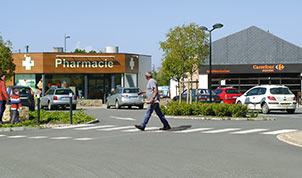KNEE LAXITY TESTS - GENOUROB'S LDA® METHOD
How to assess knee ligament damage: LDA® Method
The LDA® Method is an innovative patented technique created by company Genourob destined to the assessment of knee ligamentous laxity. It provides precise evaluation of the knee ligamentous structures by applying automated and controlled tibial translation (GNRB) or rotation (ROTAM). The LDA® Method, which stands for Automated Dynamic Laximetry (Laximétrie Dynamique Automatisée in French) Method, is a new approach to the measurement of knee laxity (aka. Laximetry) that is done through dynamic tests and with results under the form of compliance curves (=opposite of stiffness curve).
Example of a test using LDA® Method
Graph 1
The Graph 1 shows an example of tests run on both legs of a patient using the LDA® Method while applying anterior tibial translation.
How does LDA® Method work?
It is quite simple: The femur is locked in position while different forces are applied on the tibia. Both curves drawn on graph 1 represent the compliance (=opposite of stiffness) of the ligament that is measured.
Green curve: Healthy Knee
Red curve: Pathological Knee
The dynamic tests performed on each knee are done with a precision of 0.1 mm and offer a wide range of results such as the tibia/femur displacement differential and the slope of the curves.
This eventually leads to making a precise diagnostic of the state of knee ligaments (displacement differential) and knee stability (slope of the curves).
Why is the LDA method innovative compared to current methods of knee laxity assessment?
The two graphs below show the results obtained on the knees of two different patients having suffered from knee ligament injuries after a GNRB test. The green curves show the test results of the healthy knees whereas the red curves show the results of the pathological knees.
As 134 N became the international reference force for assessing the ACL thanks to the KT1000, our devices still provide the displacement for this given force. However, we can see that the displacements at this point are the same for both patients. This is problematic, as a false ACL diagnosis would be put forward. Yet, it is exactly here that the LDA Method shows innovation & precision as an additional diagnosis may be performed through the analysis of the slope of the curves.
In fact, we can determine that Patient 1 has a stable knee while Patient 2 is unstable. Why?
Because on the graph of patient 1, the ACL compliance curves (=opposite of stiffness curves) are parallel and on the graph of patient 2 the ACL compliance curves (=opposite of stiffness curves) diverge.
Consequently, this shows that patient 1 has two stable knees with a slight side-to-side difference in laxity, which remains the same. However, patient 2 clearly shows signs of an increasing side-to-side difference in laxity correlated with the increase of force applied on the knees, hence the diagnosis of an unstable knee.
This example purely states the efficiency of running dynamics tests against static tests on the knee. Considering the slope differential between both compliance (=opposite of stiffness) curves on behalf of the displacement differential between both knees ultimately leads to a much more accurate analysis of the state of the ACL present in the knee.
Use of LDA® Method
Nowadays, the LDA® Method is used in various ways to allow orthopaedic surgeons, sports doctors, radiologists and physiotherapy analyzing the state and performance of the different knee ligaments in the pre-surgery and post-surgery phase of a patient's management.
The ligamentous structures that are analyzed using the LDA® Method include:
- Objective assessment of ACL laxity using on automated version of the Lachman Test integrated in the GNRB.
- Objective assessment of PCL laxity using an automated version of posterior drawer test integrated in the GNRB PCL.
- Analysis of the ACL with medial rotation consideration using an automated version of the anterior drawer test (Lachman Test) integrated in the GNRB Rotab.
- Analysis of the knee peripheral ligamentous structures by inducing motorized tibial rotation integrated in the ROTAM.
If you want more information, please also feel free to download the "Automated Dynamic Laximetry" document just below:



